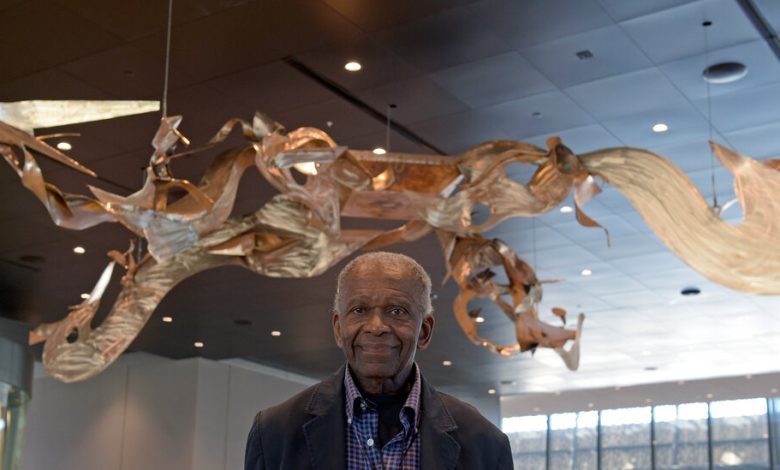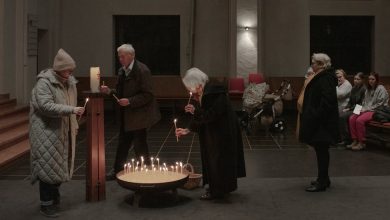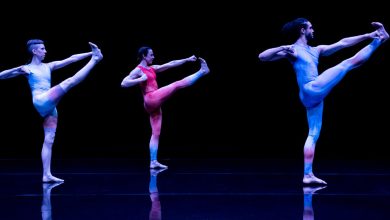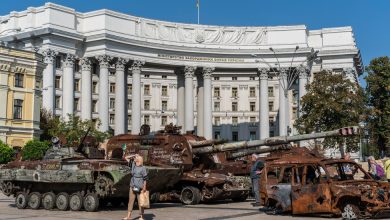Richard Hunt, Sculptor Who Transformed Public Spaces, Dies at 88

Richard Hunt, a prolific sculptor whose towering metalwork became a mainstay of American public art, and whose 70-year career drew the attention of presidents from Lyndon B. Johnson to Barack Obama, died on Saturday at his home in Chicago. He was 88.
The death was confirmed by Mr. Hunt’s studio and by his biographer, Jon Ott. A cause was not released.
Mr. Hunt, a son of Chicago’s South Side, was 19 years old in 1955 when he attended the open-casket funeral of Emmett Till, a young Black Chicagoan who grew up near Mr. Hunt and who was tortured and killed while visiting Mississippi. That searing experience helped shape the artist’s career and nudged him to experiment with welding and with forging discarded materials into art.
His work drew early acclaim. Two years after Emmett’s funeral, while Mr. Hunt was still a student at the School of the Art Institute of Chicago, the Museum of Modern Art purchased one of his sculptures, a steel work called “Arachne.” In 1964, Mr. Hunt became a visiting artist at Yale. In 1968, President Johnson appointed him to the National Council on the Arts. And in 1971, when he was 35 years old, the Museum of Modern Art displayed dozens of Mr. Hunt’s works in a retrospective exhibition.
In an appraisal of Mr. Hunt’s art that year, The Times reported that “there are really very few American sculptors of Mr. Hunt’s generation who have produced a comparable body of work so early in their development.” But because he was based in Chicago, not New York, “his reputation here has remained that of an outsider,” the 1971 article added.
Mr. Hunt’s sculptures blended classical techniques honed at Chicago’s Art Institute, where he began taking classes as a child, with self-taught soldering and welding. Using unusual methods for that time, he would scrounge in alleys for scrap metal or pick up busted parts left over from car crashes to use in his art.
He was quoted as saying, “Sculpture is not a self-declaration but a voice of and for my people — over all, a rich fabric; under all, the dynamism of the African American people.”
Over the decades, Mr. Hunt became known for his soaring pieces of public art, more than 160 of which have been displayed across the country, according to his studio. Those include “Swing Low,” a 1,500-pound work of welded bronze that hangs from a ceiling at the Smithsonian National Museum of African American History and Culture, and “Flight Forms,” an imposing work of welded stainless steel outside Chicago’s Midway International Airport. Other works created by Mr. Hunt have been installed in locations as varied as a sculpture garden in Kansas, a museum in Kentucky and a playhouse in Michigan.
A recently completed work, which depicts a bird taking flight from a book, is set to be displayed at the Obama Presidential Center in Chicago once that facility opens. Mr. Obama has called Mr. Hunt “one of the greatest artists Chicago ever produced.” The city’s mayor, Brandon Johnson, said in a statement that the sculptor made an “indelible impact on our city and our world.”
Richard Howard Hunt was born on Sept. 12, 1935, in Chicago, the first of two children born to Cleophus Howard Hunt, a barber, and Etoria Inez Henderson Hunt, a librarian. He took an early interest in art, often visiting Chicago’s museums, where he was captivated by works from Africa. As a young teenager, he began taking classes at the Junior School of the Art Institute of Chicago.
Mr. Hunt is survived by his daughter, Cecilia, an artist, and his sister, Marian, a retired librarian.
Mr. Hunt would say that his attendance at the Till funeral nearly 70 years ago helped establish the course for his career. Like Emmett, Mr. Hunt was a Black teenager from Chicago who sometimes traveled to the South to visit relatives. The artist was quoted as saying that what happened to Emmett “could have happened to me.”
“That really set the tone for his entire artistic life, which was really focused around representing freedom, and freedom in every sense,” said Mr. Ott, the biographer.
Even as his work drew the attention of art collectors and political leaders, Mr. Hunt spent much of his adult life sleeping on a mattress on the floor of his Chicago studio, which had no television, few amenities and huge piles of scrap metal with which he and his colleagues would build.
The studio building, which he acquired in 1971, blends into a tree-lined residential streetscape in an affluent part of Chicago’s North Side. But inside, the high-ceilinged space, which had been a substation for powering the city’s elevated rail lines, is a living museum.
Alongside half-built sculptures and mementos from his career, Mr. Hunt had continued to work well into this year and to supervise other sculptors carrying out his vision for public art installations. One of his final pieces, Mr. Ott said, had been a sculptural model for a monument to Emmett Till.
The plan, Mr. Ott said, is for other sculptors who worked with Mr. Hunt to complete a large-scale version of that piece, which will eventually be displayed outside Emmett’s childhood home, just two blocks from where Mr. Hunt was born.





